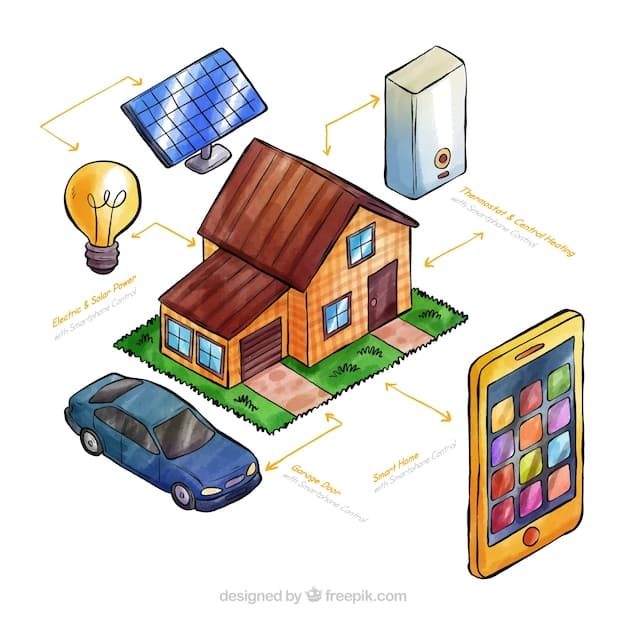Solar Tax Credits 2025: Will Homeowners Save Money?

The financial impact of new tax credits for solar panel installation in 2025 is poised to offer significant savings for US homeowners through substantial federal incentives and potential state and local programs, enhancing renewable energy adoption and long-term energy independence.
The prospect of new federal tax credits for solar panel installation in 2025 raises a crucial question for many: Financial Impact: Will the New Tax Credits for Solar Panel Installation Save US Homeowners Money in 2025? As energy costs fluctuate and environmental consciousness grows, understanding the financial implications of adopting solar power is more pertinent than ever for American households.
Understanding the Renewed Federal Solar Tax Credit
The federal solar tax credit, officially known as the Residential Clean Energy Credit, has been a cornerstone of solar adoption in the United States, providing a direct reduction in the amount of income tax an individual or household owes. This credit has been instrumental in making solar energy more accessible by significantly cutting down the upfront costs associated with installation. Its continuity and potential adjustments for 2025 are pivotal for homeowners considering the switch to solar.
Initially established to promote renewable energy, the credit has seen various iterations and extensions. Its design is fairly straightforward: a percentage of the cost of a new, qualified solar electric system for your home can be claimed as a credit on your federal income taxes. This isn’t a deduction; it’s a dollar-for-dollar reduction of your tax liability, which is far more impactful for most taxpayers.
The Investment Tax Credit (ITC) Explained
- The ITC is a nonrefundable tax credit, meaning you won’t get a refund for more than you owe in taxes, but you can carry over any unused credit to future tax years.
- It covers the cost of solar photovoltaic (PV) panels, labor for installation, mounting equipment, inverters, wiring, and even certain battery storage devices installed with the solar system.
- Historically, the credit has been a significant incentive, and its extension at a robust percentage is a clear signal from the government regarding its commitment to clean energy.
For 2025, the credit is expected to remain at 30% for systems placed in service. This percentage makes a substantial difference in the total cost of a solar installation, often turning a prohibitive expense into a manageable investment. The stability of this percentage provides a predictable framework for homeowners planning their energy transitions.
The eligibility criteria for the tax credit are generally broad, covering homeowners who install new or first-use solar panels on their primary or secondary residences. Rental properties are typically not eligible unless the homeowner also resides there for part of the year. This broad applicability ensures that a wide range of US homeowners can benefit from this federal incentive, fostering widespread adoption of solar technology.
Beyond Federal: State and Local Solar Incentives
While the federal tax credit is undeniably powerful, its effectiveness is often amplified by a mosaic of state and local incentives. These programs vary widely by region, reflecting diverse energy goals, economic conditions, and environmental priorities. For a homeowner, combining federal, state, and local benefits can dramatically reduce the net cost of a solar installation, making the decision to go solar profoundly more attractive. These diverse programs ensure that the financial landscape for solar adoption is unique to each local context, requiring careful investigation to fully capitalize on available savings.
Many states offer their own tax credits, rebates, or performance-based incentives. For instance, some states might provide a direct rebate for each watt of solar capacity installed, while others might offer tax credits that stack on top of the federal one. These state-level incentives are crucial because they can often address specific regional barriers to solar adoption, such as higher initial costs or particular grid infrastructure challenges.
Common Types of State and Local Incentives
- State Tax Credits: Similar to the federal credit, these offer a dollar-for-dollar reduction in state income tax liability.
- Rebates: Direct upfront payments or reductions in the purchase price of solar equipment, often administered by utility companies or state energy offices.
- Property Tax Exemptions: Exemptions from increased property taxes that would normally result from the added value of a solar system. This prevents homeowners from being penalized for a valuable home improvement.
Net metering policies are another vital component of state-level support. Net metering allows solar system owners to send excess electricity generated by their panels back to the grid in exchange for credits on their utility bills. This mechanism effectively turns a home into a miniature power plant, allowing homeowners to reduce or even eliminate their monthly electricity bills. The long-term savings from net metering can be substantial, adding another layer to the financial benefits of solar.
Local municipalities and even specific utility companies often have their own unique programs. These can range from low-interest loan programs for solar installations to special grants for low-income households or community solar projects. Navigating these local incentives requires some research, but the effort can yield significant additional savings. Homeowners should consult their state energy office websites or local solar installers for the most up-to-date and specific information on programs available in their area, as these incentives are frequently updated or modified.
Evaluating the Long-Term Financial Payback Period
The decision to install solar panels is a considerable investment, and understanding its long-term financial payoff is paramount for homeowners. The payback period—the time it takes for the savings from your solar panels to equal the initial investment—is a crucial metric. While the upfront cost can seem daunting, incentives like the federal tax credit significantly shorten this period, making solar power a more financially viable option much sooner than many realize. The benefits unfold over the system’s lifespan, often surpassing initial expectations.
Several factors influence the payback period, including the initial system cost, available incentives, local electricity rates, and a home’s energy consumption patterns. A higher upfront cost naturally extends the payback period, but a substantial 30% federal tax credit dramatically lowers this barrier. For example, a $30,000 solar system could effectively cost $21,000 after the federal credit, immediately reducing the financial burden and accelerating the return on investment. This reduction in capital outlay is a key driver for solar adoption.
Key Factors Influencing Payback Period
- Initial System Cost (post-incentives): The actual amount you pay after all tax credits, rebates, and grants are applied.
- Electricity Rates: Higher electricity rates mean greater savings from generating your own power, leading to a faster payback.
- Energy Consumption: Homes with higher energy usage tend to see greater financial benefits as they offset more expensive grid electricity.
The lifespan of solar panels is another critical consideration, typically ranging from 25 to 30 years or even more for high-quality installations. Once the payback period is reached, typically within 6 to 10 years for many US households, every unit of electricity generated by your panels represents pure savings. This means potentially decades of free or heavily discounted electricity, significantly reducing household utility expenses over the long haul. This extended period of savings is where the true financial power of solar energy manifests itself.

Improvements in solar technology, such as increased efficiency and durability, also contribute to a faster and more reliable return on investment. Modern solar panels are more efficient at converting sunlight into electricity, meaning you can generate more power from a smaller footprint, enhancing overall savings. Additionally, the declining costs of solar equipment over the past decade have made the initial investment more accessible, further shortening payback periods for new installations. This continuous evolution of technology makes solar an increasingly attractive proposition.
Analyzing Potential Savings on Electricity Bills
One of the most immediate and tangible benefits of installing solar panels is the direct reduction in monthly electricity bills. For many homeowners, this translates into substantial savings, especially in regions with high utility rates. By generating your own clean electricity, you diminish your reliance on the grid and its fluctuating prices, establishing a degree of energy independence. This direct impact on household budgets is a primary motivator for investing in solar, providing a consistent financial upside.
The extent of your savings depends largely on your energy consumption habits and the size and efficiency of your solar system. A well-designed system, sized appropriately for your household’s needs, can offset a significant portion, if not all, of your electricity usage. In some cases, with effective net metering policies, homeowners can even generate excess electricity and receive credits from their utility company, leading to bills that approach zero or even positive credits. This potential for near-elimination of electricity costs is a powerful economic incentive.
Factors Affecting Electricity Bill Savings
- System Size and Output: A larger, more efficient system will generate more electricity, leading to greater offsets.
- Household Energy Consumption: Reducing your overall electricity usage through energy efficiency measures can maximize the impact of your solar generation.
- Utility Rate Structure: Different utility companies have varying rate schedules, including time-of-use rates or tiered pricing, which can influence savings.
The stability of electricity costs is another important aspect. Traditional utility bills are subject to unpredictable rate increases, influenced by factors like fuel costs, infrastructure investments, and regulatory changes. By contrast, once installed, the “fuel” for your solar panels—sunlight—is free and abundant. This provides long-term predictability to your energy expenses, insulating you from future utility rate hikes. This financial stability is a significant advantage in managing household finances over decades.
Over the typical 25-30 year lifespan of a solar system, the accumulated savings on electricity bills can be enormous, often far exceeding the initial investment. These long-term savings contribute to the overall wealth of a household, freeing up capital that can be allocated to other financial goals or simply enjoyed. Even if you sell your home, solar panels often increase property value, passing on ongoing savings to the new owners. This makes solar a smart investment not just for current consumption but also for future property value.
Considering the Impact on Home Property Value
Beyond the direct financial savings on utility bills and tax credits, installing solar panels can significantly enhance a home’s property value. This often overlooked benefit adds another layer of financial return on investment for homeowners. A solar-equipped home is increasingly seen as a modern, energy-efficient asset, appealing to a growing segment of environmentally conscious homebuyers. This translates into a competitive edge in the housing market, offering both tangible and intangible benefits for sellers.
Studies consistently show that homes with solar panel installations sell faster and for a premium compared to similar homes without solar. The exact increase varies depending on location, market conditions, and the size and age of the solar system, but it is typically a substantial percentage of the system’s cost. This added value is driven by the prospect of reduced future utility bills for the new homeowner, a highly attractive proposition in a market where energy costs are a constant concern.
Aspects of Property Value Enhancement
- Increased Home Appeal: Solar installations are a visible sign of modern energy efficiency, appealing to eco-conscious buyers.
- Faster Sales: Homes with solar tend to spend less time on the market, indicating higher demand.
- Future Savings as a Selling Point: Prospective buyers are willing to pay more for homes that promise lower ongoing operational costs.
It’s important to differentiate between owning a solar system and leasing one. Homeowners who purchase their solar panels outright typically see the most significant increase in property value, as the system becomes an integral part of the home’s infrastructure. Leased systems, while still offering electricity bill savings, may not provide the same property value boost and can sometimes complicate the selling process. Potential buyers may be hesitant to assume a long-term lease agreement. Thus, outright ownership often yields the best long-term financial outcomes.

The investment in solar panels is therefore not just about immediate savings; it’s also about a strategic enhancement to a major asset. Even if a homeowner plans to sell their property within the solar system’s payback period, a significant portion of the initial investment can often be recuperated through the increased sale price. This dual benefit of energy savings and property value appreciation makes solar a financially sound decision for many US households, offering returns both during occupancy and upon sale.
Navigating Challenges and Considerations for 2025
While the financial prospects for solar panel installation in 2025 appear highly favorable, homeowners must also navigate several challenges and considerations to maximize their benefits. The landscape of renewable energy is dynamic, influenced by technological advancements, policy shifts, and market trends. Understanding these potential hurdles is crucial for a smooth and successful transition to solar power, ensuring that the expected savings materialize as planned. Careful planning and due diligence are essential.
One primary consideration is the continued evolution of state and local incentive programs. While the federal tax credit is widely expected to remain stable, state-level policies, particularly around net metering, can and do change. Some states have adjusted or phased out favorable net metering policies, which can impact the long-term savings for new solar owners. Homeowners should research their local energy regulations thoroughly and understand any planned changes that might affect their projected financial returns. Staying informed is key to making sound investment decisions.
Potential Challenges to Address
- Policy Changes: Shifts in state or local net metering rules or other incentive structures.
- Equipment and Installation Costs: While generally declining, supply chain issues or increased demand could temporarily affect pricing.
- Installer Selection: Choosing a reputable and experienced solar installer is crucial for system performance and warranty validity.
The initial investment, even with incentives, remains a significant outlay. Financing options, such as solar loans or Power Purchase Agreements (PPAs), offer ways to go solar with little to no upfront cost. However, each option has its own terms, interest rates, and implications for long-term savings and property value. Homeowners should carefully evaluate these financing models against their financial goals and risk tolerance. Understanding the fine print of any financing agreement is paramount to avoid unforeseen costs.
Technological advancements also bring both opportunities and considerations. As solar panel efficiency continues to improve, homeowners might face decisions about waiting for next-generation technology or installing current, proven systems. Additionally, the integration of battery storage solutions is becoming more common, offering enhanced energy independence but adding to the initial cost. Weighing these technological factors against current needs and budget is an important step in the planning process, ensuring a future-proof investment.
Ultimately, the successful adoption of solar in 2025 will depend on homeowners conducting thorough research, engaging with reputable installers, and staying informed about the evolving policy and technology landscape. While the path to solar energy is promising, a proactive approach to these considerations will ensure that American households indeed save money and enjoy the multitude of benefits that solar power offers. It’s an investment that requires diligence but offers significant rewards.
| Key Aspect | Brief Description |
|---|---|
| 💰 Federal Tax Credit | Expected to remain at 30% for 2025, offering significant federal tax liability reduction. |
| 💲 State & Local Incentives | Diverse programs like state tax credits, rebates, and net metering amplify savings. |
| 🏠 Property Value Boost | Solar panels enhance home value and appeal, leading to faster sales at a premium. |
| ⚡ Bill Savings & Stability | Significant reduction in monthly electricity bills and protection from future rate hikes. |
Frequently Asked Questions About Solar Tax Credits
The Residential Clean Energy Credit is a federal tax credit that allows homeowners to deduct a percentage of the cost of installing a new solar energy system from their federal income taxes. For 2025, it is expected to remain at 30%, making solar installations significantly more affordable for eligible US taxpayers.
Yes, absolutely. The federal solar tax credit can typically be stacked with various state, local, and utility-specific incentives, such as state tax credits, rebates, and property tax exemptions. Combining these programs can further reduce the overall cost of solar panel installation, maximizing your savings.
Solar panels typically increase a home’s property value, making it more attractive to potential buyers. Homes with owned solar systems often sell faster and for a premium compared to those without. This added value stems from the promise of reduced future utility bills, a significant benefit for new homeowners.
The payback period for solar panel installation, the time it takes for savings to equal the initial investment, generally ranges from 6 to 10 years for many US households. This period is heavily influenced by the initial system cost, available incentives, local electricity rates, and household energy consumption.
Yes, homeowners should consider potential policy changes in state incentive programs, fluctuations in equipment costs, and the importance of selecting a reputable installer. Researching local regulations and understanding financing options are crucial steps to ensure a smooth and financially beneficial solar transition.
Conclusion: A Bright Outlook for Solar Savings in 2025
In conclusion, the answer to the question, “Financial Impact: Will the Sew Tax Credits for Solar Panel Installation Save US Homeowners Money in 2025?” is a resounding yes. With the robust federal Residential Clean Energy Credit expected to remain at 30%, coupled with a diverse array of state and local incentives, US homeowners are uniquely positioned to achieve substantial financial savings. Beyond the immediate reduction in installation costs, the long-term benefits of lower electricity bills, increased energy independence, and enhanced property value solidify solar as a sound and profitable investment for the coming year and beyond. The consistent evolution of technology and supportive policies make 2025 an opportune time for American households to embrace solar energy.





